I have been to Victoria Falls and Niagara Falls and spent hours walking up and down steps to visit falls in various parts of the world, so why visit Iguazu Falls? What could be so great about another load of water falling?
When I saw the falls, I said, “Wow.” This is the only time I remember using that word to describe anything. I was impressed, and this is a rarity when you do a lot of travelling.
There were waterfalls in both directions. I stood only a few feet away from the falls, where you had to shout above the noise. I walked above the water as the full force crashed below, churning and pushing to get to the front, and we got drenched. There were waterfalls after waterfalls. It seemed like all the water in the world was pouring over the edge; surely, they would run out of water eventually.
It is well worth coming to these falls.
Where are the falls
The falls are on the border between Brazil and Argentina, not far from Paraguay.
On the Brazilian side, they are near the city of Foz do Iguaçu. On the Argentine side, they are near the city of Puerto Iguazú.
Facts about the falls
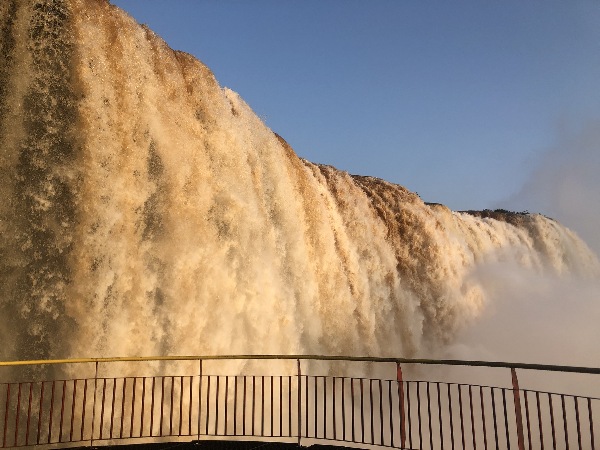
The Iguazu Falls are on the Iguazu River. The edge of the falls is 1.7 miles (2.7 km) long. Numerous islands divide the water into smaller waterfalls. Depending on the river’s flow, there are between 150 and 300 waterfalls.
The depth of the waterfalls is between 197 and 269 feet high (60 and 82 m).
Out of the three major falls, Victoria Falls, Niagara Falls and Iguazu Falls, Victoria Falls is the tallest. Niagara Falls, on average, has the largest flow of water, and Iguazu Falls is the widest.
How to get there
Both Foz do Iguaçu and Puerto Iguazú have airports. They mostly have flights from other parts of Brazil or Argentina. Which airport you fly to depends on where you are flying from. We flew to Foz do Iguaçu and crossed the border to Argentina, but we had to return to Brazil to go back to Rio. Buses also go to both cities, as they are major tourist destinations. They are cheaper but can be very long journeys.
From Foz do Iguaçu, it is 12 miles (19 km) to the entrance of the falls (Parque Nacional do Iguaçu), and it takes about 35 minutes to drive there. You can go by bus from the bus station or by taxi.
From Puerto Iguazú, it is 10.5 miles (17 km) and takes about 28 minutes to drive. Again you can go by bus or taxi.
When to go
It rains all year, but the heaviest period is October to February. Come just after this period to see the falls at full volume. However, sometimes, they have to close part of the park when the water gets too high, and they cancel the boat ride. So there is no guarantee you will see the park’s highlights.
I would avoid June, July, and August when there is less rain and water flow. Nonetheless, even when the water flow is low, it is still spectacular.
I would choose a period when the temperature is comfortable for you. I went in September when the humidity was lower, and the temperature reached about 27C (81F) during the day. September to the end of January has the lowest humidity. When the humidity is high, you can feel sticky and uncomfortable. The lowest temperature is from May to the end of July 23-24c (75F). This is when the flow is lower.
If you go when the flow is high, you won’t enjoy it if you are hot, tired, and grumpy. Some people feel quite sick when stuck in the train queues, with no shade and a high temperature.
The other thing to consider is the crowds. The busy period is from December to February, Easter, and the last two weeks in July. Also, avoid public holidays and weekends. You will spend most of your time walking along pathways at the same speed as the person in front. If there are crowds, you might need to push your way to the front at the viewpoints.
If you must go during the busy season, get in the ticket queue as soon as it opens. Don’t stop to get food; get on the first vehicle available. If you are on the Argentine side, make Devil’s Throat your priority.
How long to spend there
The Brazilian side can be seen in half a day, and most of the Argentine side can be explored in a day. Crossing from the Brazilian to the Argentine side takes 1 to 2 hours. You, therefore, need two whole days to explore.
You can do it in one day if you rush and beat the crowds. It is a matter of luck and good timing, but you won’t have much time to look around. It will then become more of a race rather than an enjoyable day.
What to take
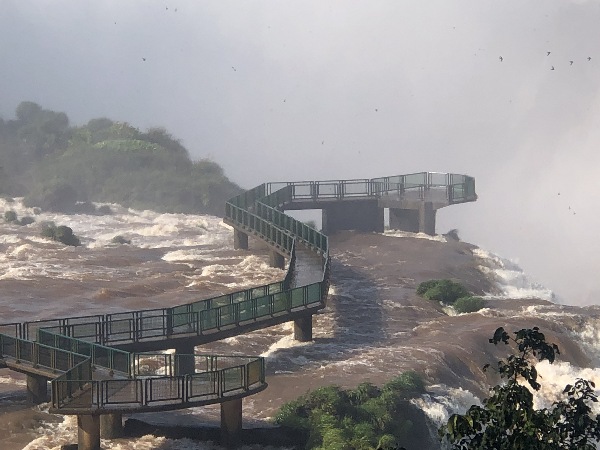
Disposable rain poncho: it gets damp, but it is hot and humid, so something light is best.
Waterproof camera case
Mosquito repellent
Suntan lotion
Comfortable shoes with a good grip. I slipped a couple of times on a wet metal path.
Water and snacks: Although they sell these, they are only available in a few areas.
A change of clothes if you are going on a boat ride as you will get drenched.
Tickets and opening hours
You can buy your tickets in advance, but it is not necessary. As the falls are in two countries, you must purchase tickets for each park.
In Brazil, children under 7 are free. Today, the price is £16, US$20.The price changes because of currency fluctuations. See this link for the most up-to-date prices. https://cataratasdoiguacu.com.br/
The park used to open at 9 a.m., but in 2024, it changed to 8 a.m.– 18:00, and the last entry was 16:30.
At the moment, it looks like it is 9 a.m. to 16:00 at weekdays and 8:30 to 16:00 on weekends. However, I would check the times near your visit as they seem to keep changing.
Argentine tickets today cost £34, US$43 for adults; for children 6-16, it is £15, US$19, and for those under 6, they are free. For up-to-date prices, look at. https://iguazuargentina.com/en/nosotros
They also have flexi passes, which offer additional days at a discount.
The park is open from 8:00 to 18:00, and the last entry is at 16:30.
If you have brought your ticket in advance, download it, as you might not get reception. A few people have found their credit cards were not accepted, so it might be helpful to have some backup cash.
The Brazilian side
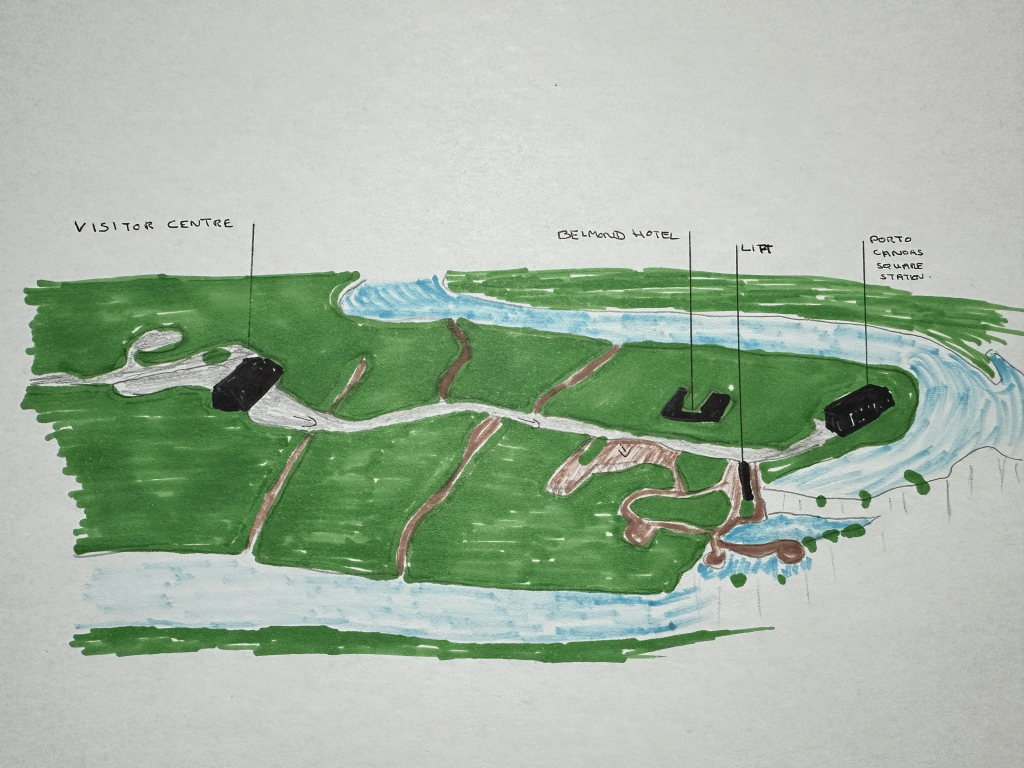
You line up at the visitor’s centre for your slot on the bus. The bus might stop at the Poço Preto Trail Stop and the Macuco Safari Stop, but only if requested. The stop for the falls is easy to spot as the Belmond Hotel is on the left. This Stop is the Path of the Falls stop.
As you get off the bus, a viewpoint gives you your first spectacular view of the falls. To the left, a path goes alongside the river, providing panoramic views of multiple waterfalls. The path is not very difficult, but there are a few steps. If you find walking difficult, you can return to the bus and leave at the next stop. It’s hard to say how long it takes to walk the path because we stopped to take so many photos, but it is just over ½ mile long (1 km).
Near the end of the path, there is a walkway over the churning water, where you will get wet. You don’t need to take this path if you want to remain dry. We did this early in the morning. We were the only people there, and we got soaked. We might have had more protection in a crowd, but it was great fun. You feel like you are in the middle of a storm.
At the end of the path, you get up close to a waterfall. It is loud, and you can see the full force of the water.
There is a shop and a lift to more shops and restaurants. You can take the bus back to the Belmond Hotel or continue to the Visitor’s Centre.
The Argentinian side
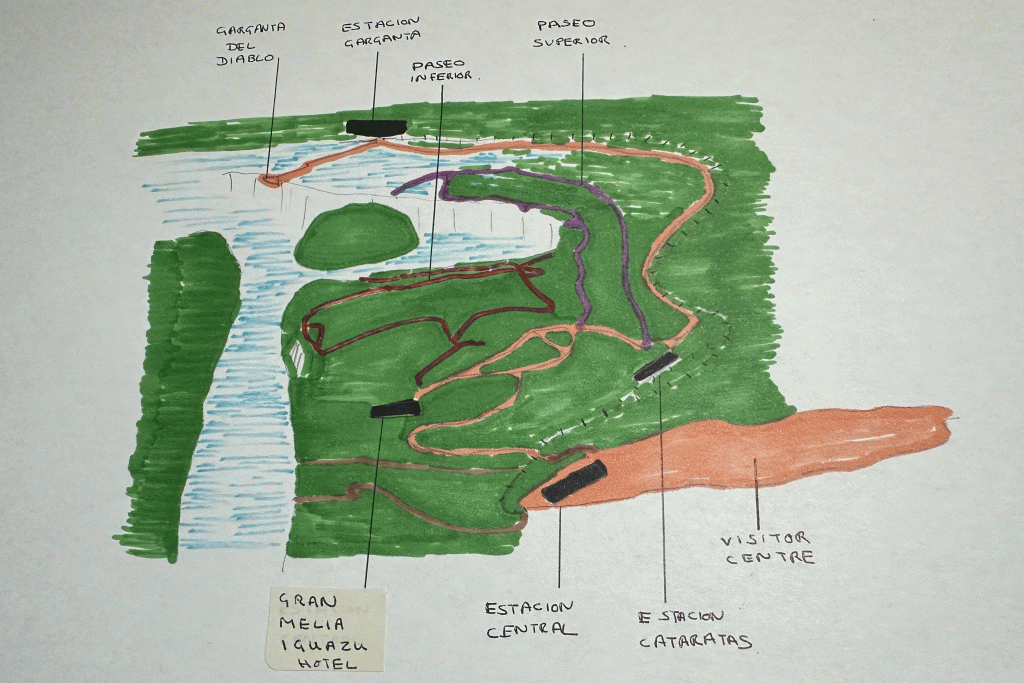
When you arrive at the visitor’s centre, buy or show your ticket. Then you need to pick up a train ticket. This is included in your ticket price but tells you which train you are allowed on. Head towards the station Estacion Central.
Once on the train, it is best to head to Garganta del Diablo first, which is at the second stop. However, sometimes you must get out at the first stop and queue again for the train. There are always crowds at Garganta del Diablo. Here, you get a close look down the waterfall. The water is noisy and violent as it surges downward into a big pit. You can understand why it is called Garganta del Diablo, the devil’s throat. The sheer force and noise is a bit frightening.
Next, you can return by train to the station Cataratas (next stop). You can find restaurants, toilets, and the entrance to two walks near this station.
The lower path also called the Inferior path (Paseo Inferior), takes about 90 minutes and is just over a mile long (1.5 km). You can see a couple of tiny waterfalls, which you can walk above or below. You can see across to the waterfalls on the opposite side of the valley in a few places. There are steps. We went very early in the morning, and there seemed to be a lot of mist, so I had difficulties taking a good photo.
The other walk is the Upper Trail, also called Superior (Paseo Superior). It takes 2 hours and is just over 1 mile (1.7 km). There are no steps, and it is suitable for pushchairs or wheelchairs. You walk along boardwalks, which are just above the falls in some places. You will see the horseshoe shape of the falls and can look across the valley to Brazil and the Hotel Belmond. After seeing the falls, you walk back through the rainforest.
I would probably do the upper trail if you only have time for one walk. The times stated for the walks are the average times. You can do them quicker if there are no crowds and you limit the number of photos you take.
Note that the paths close a couple of hours before the park closes. Once closed, staff members walk along the paths to ensure people don’t stay too long.
Boat rides

If you go in the speedboat, you will get drenched. If you stand in a shower at home fully dressed, imagine the water falling ten times as hard and fast, and you will get an idea of the experience.
You will experience the waterfalls close up and under, and it is not something you will forget. You go under multiple waterfalls and eventually emerge dripping. People find this super fun, so you might want to consider it.
Macuco Boat ride is in Brazil; they call it a safari. You get to ride in an electric vehicle for 1½ miles (2km) and go on an ½ mile (1 km) walk. Don’t forget to use mosquito repellent. You will be given life jackets for the ride. There are lockers which you must pay for. Remove your shoes if you don’t want them to get wet. You go under the falls about 4 times and deliberately hit one of the waves, which gets more water aboard. Back on land, there are changing rooms.
This boat ride might be better suited to the less able. You don’t have to do the jungle walk if you don’t want to. They say they have some rides for those who don’t want to get soaked. They don’t have an age limit, but be aware that in Argentina, they think the rides are unsuitable for those under 12. You know your own child, but some young children are terrified by the experience. The rides are every 10 minutes. However, there are a lot of reports of people having to wait hours to get on the boat.
The Great Adventure runs the speed boats on the Argentine side. There are age and health restrictions, as well as being down a 150-meter staircase. The health restrictions include wearing hearing aids. They have boats every 75 minutes starting from 9:00 am.
You are taken on a 5.5 km ride through the jungle and given waterproof bags to put your belongings in. You are also given a life jacket. Remember to keep your passport dry; it could be ruined even if you leave it in an inside jacket pocket.
Only time for one side
It would be a great shame if you only had time for one side, as you would only experience half the place. Both sides are great. People seem to prefer the side they visit first, probably because this impacts them most.
Most of the falls are on the Argentinian side, and you can see them best from Brazil. The Argentinian side allows you more chances to come close to the water and appreciate its full force. On the Argentinian side, you are at the top of the falls, while most of the Brazilian side is looking across at the bottom of the falls. There isn’t a better side, just different views.
Where to eat
There are plenty of places to pick up food in the parks. You will find the typical mass-market food and some good restaurants.
On the Brazil side, the food can be found at the end of the road near the Porto Canoas Square Station.
On the Argentina side, food is available at the entrance and in the central area, follow the signs from Estacion Cataratas.
Interestingly, on the Argentine side, the people in the café sit in what looked like a big cage, presumably to stop the monkeys and coatis from pinching the food. Outside the café are picnic tables, but if the monkeys or coatis want your picnic food, you have to fend for yourself.
Toilets
Toilets can be found near the stations on the Argentine side and near the fast-food Dos Hermanas. On the Brazil side, they are at the entrance, at the end of the pathway by the elevator, and by the food court, where you get the bus to return.
Where to stay
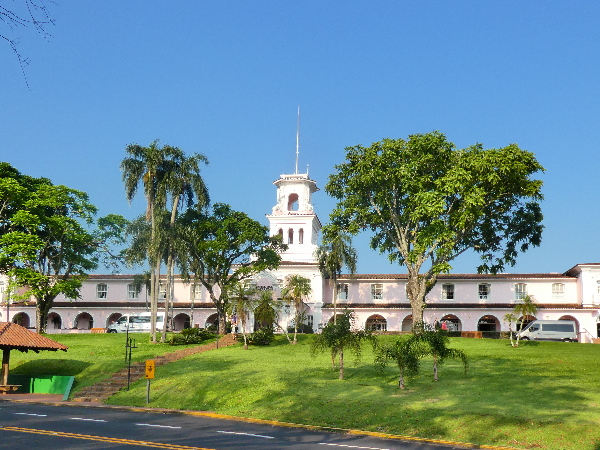
If you are on the Brazilian side, I highly recommend a Belmond Hotel, the Hotel Das Cataratas. It is on the pricey side, but you can’t beat its location inside the park. You can see the falls before and after all the tourists have been. We went before breakfast, had the falls to ourselves, and went back during the day and again late in the evening. The path along the falls starts outside the hotel. You pay for your park entrance at the hotel.
While the crowds were high, we spent the day relaxing in the pool. This hotel would be very nice even if it didn’t have a fantastic location. A few hotels are worth splashing out for because of their location, and this is one of them.
On the Argentina side, the closest hotel is Gran Meliá Iguazú. It gets good reviews, but we didn’t like this hotel. When we visited, it was much more expensive than the Belmond Hotel and had inferior service. We couldn’t see the restaurant menu as it wouldn’t download on our three devices, and the reception couldn’t let us see a copy. We ordered food to be delivered to our room, as we could see that menu, but it took 2 hours and numerous phone calls before it came.
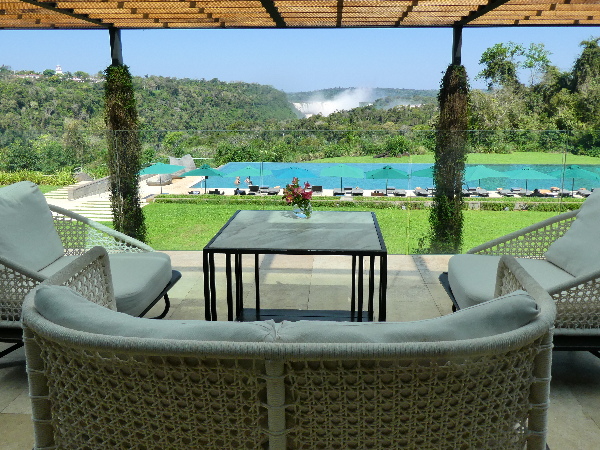
The hotel has a view along the falls, but you can’t enter the walkways or see the falls earlier than the general public. We chose this hotel because we could pop back to see our daughter, who didn’t want to explore every part of the falls. Next time, I would choose a cheaper hotel in Puerto Iguazú and splash out by getting a taxi to the park’s entrance.
Wildlife
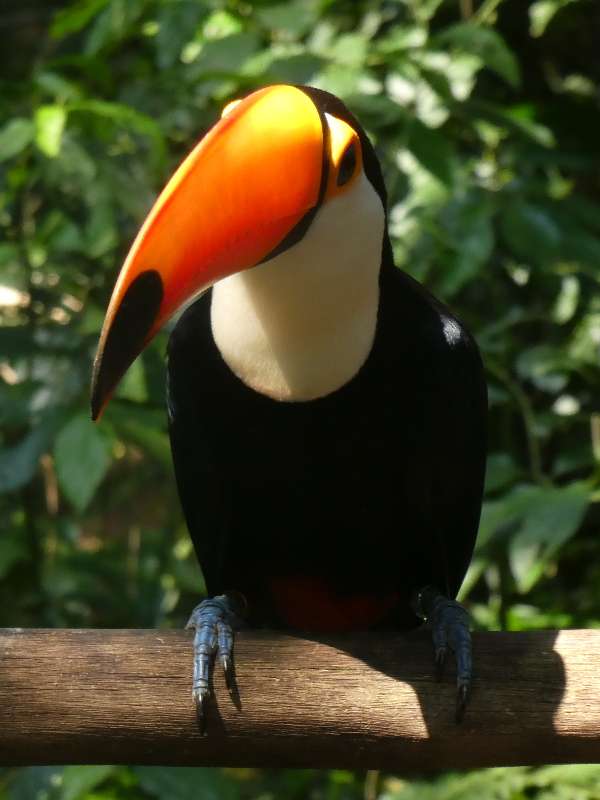
Coatis can easily be seen in the parks, especially in the early mornings and late evenings when fewer guests are around. You shouldn’t feed these animals. We watched two coatis fight each other, and they seemed very vicious. They were fighting along the side of the drop into the falls and were not the least worried that one slip would be fatal.
Toucans can be seen in the trees. One day, we spotted a tree with five toucans sitting on it.
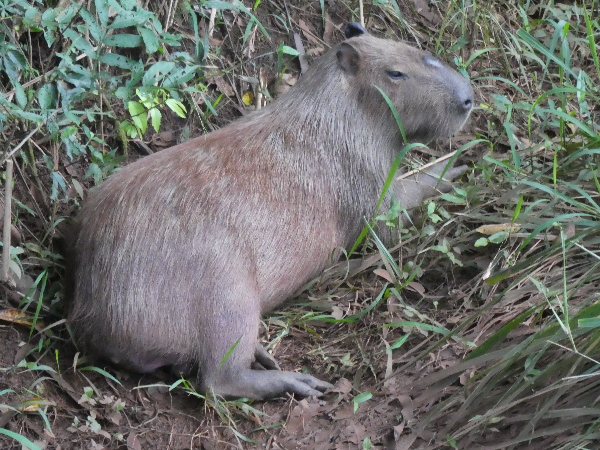
Capybara: When I first saw this animal, I had no idea what it was. I saw one lying at the water’s edge and wondered if it was dead. However, it later moved. Capybaras are good swimmers, which is just as well as the currents are powerful in this area.
Capuchin and howler monkeys can be found everywhere and can be a nuisance. At our hotel in Argentina, we were told to keep our balcony door shut, or they would get in.
Crossing the border
You can take a bus to the Brazilian border, get off to go into the immigration office, catch another bus to the Argentinian border immigration office, and then catch a bus to Puerto Iguazu.
However, we used a private transfer that our hotel arranged, and we found the procedure straightforward.
You can drive with the correct paperwork, including a Carta Verde.
Don’t forget to check if you need a visa to cross the border.
Other places to visit
Paraguay is only 15 miles from Puerto Iguazú and even closer to Foz do Iguaçu. When we asked on message boards what the best way to go was, many replied that it was unsafe and that the border town was full of shops and not the high-end type.
We hired someone to drive us for the day and found it enjoyable. With a guide, we never felt unsafe. We did see some shops, but only on the way to our lunch stop.
Itaipu Dam is the largest hydroelectric dam in the world. To see inside, you must book your tickets in advance. They offer a tour in English. Otherwise, you can take a bus that takes you along by the dam so you can appreciate its size. This was more my husband’s type of thing, but I did enjoy seeing more capybara.
Parque das Aves is a bird park on the Brazil side near the entrance to the falls. We saw lots of unusual birds. They have some enclosures that you can walk through. We had a toucan sit right next to us. If you stay at the Belmond Hotel, you can take the hotel’s shuttle bus to the entrance and back. It is only a short walk to the bird park.
Marco Das Tres Fronteiras in Brazil. From here, you can see Argentina and Paraguay. There is a restaurant, snack stalls, bars, and tourist shops. A popular photograph is a board with three signs pointing to Brazil, Argentina, and Paraguay. In the evening there is a show with dancers from Brazil, Argentina and Paraguay.
This place might be worth visiting if you have spare time, but it is not a significant attraction. Some people find it looks fake, and little English is spoken even though foreigners pay more. If you decide to come, arrange a taxi to pick you up after the show. There are a few taxis, but they disappear quickly after the show, and you might not get a good signal on your phone.
Summary
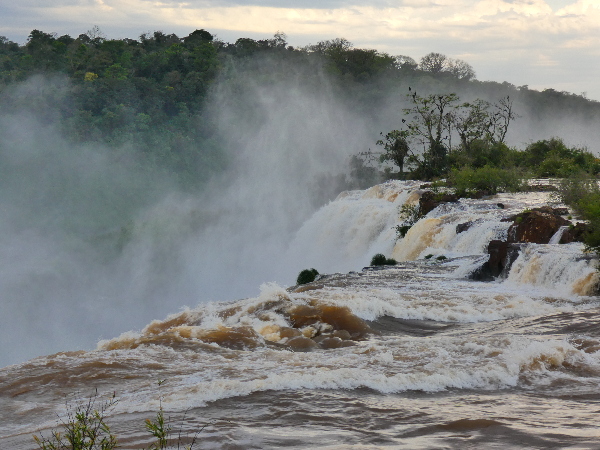
Everyone who goes to the falls is impressed. Some might complain about the organisation or crowds, but everyone agrees the falls are incredible. If you can go, don’t wait—book your trip now. You don’t often get a chance to see the earth’s full power rush beside you.
Have a great trip, take loads of photos and don’t forget your poncho.
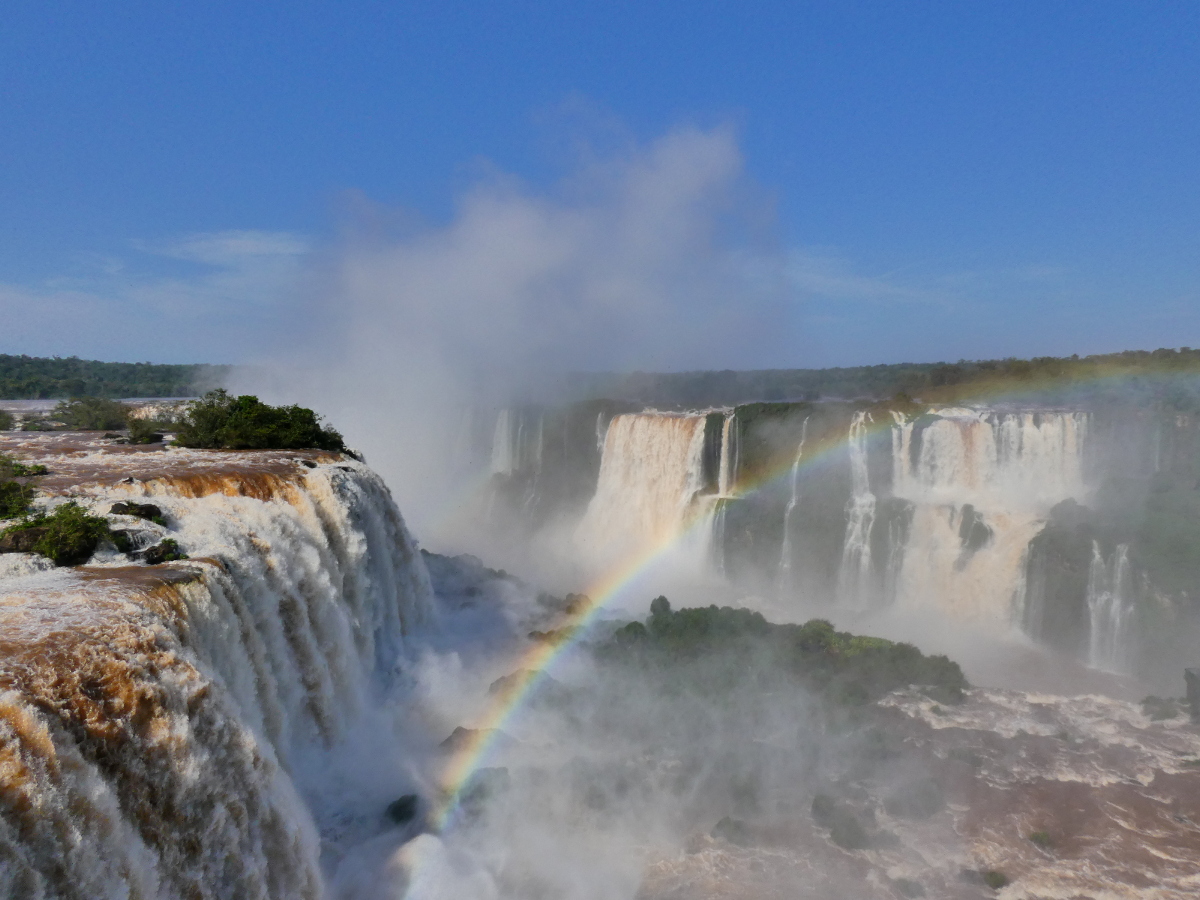
Leave a Reply